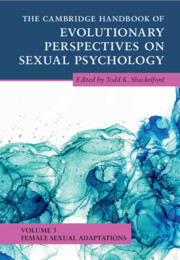Book contents
- The Cambridge Handbook of Evolutionary Perspectives on Sexual Psychology
- The Cambridge Handbook of Evolutionary Perspectives on Sexual Psychology
- Copyright page
- Contents
- Contributors
- Preface
- Part I Precopulatory Adaptations
- Part II Copulatory Adaptations
- Part III Postcopulatory Adaptations
- 13 Mate Retention
- 14 Shifts in Partner Attractiveness
- 15 Emotional Commitment
- 16 Female Sexual Jealousy
- 17 On Attachment and Evolution: Recounting the Story of, and Stories in, Attachment Theory
- 18 Maternal Filicide
- Index
- References
18 - Maternal Filicide
from Part III - Postcopulatory Adaptations
Published online by Cambridge University Press: 30 June 2022
- The Cambridge Handbook of Evolutionary Perspectives on Sexual Psychology
- The Cambridge Handbook of Evolutionary Perspectives on Sexual Psychology
- Copyright page
- Contents
- Contributors
- Preface
- Part I Precopulatory Adaptations
- Part II Copulatory Adaptations
- Part III Postcopulatory Adaptations
- 13 Mate Retention
- 14 Shifts in Partner Attractiveness
- 15 Emotional Commitment
- 16 Female Sexual Jealousy
- 17 On Attachment and Evolution: Recounting the Story of, and Stories in, Attachment Theory
- 18 Maternal Filicide
- Index
- References
Summary
Evolutionarily informed perspectives offer a comprehensive theoretical approach to parental investment, as they include not only explanations for why an individual makes such investment, but also for why an individual might withhold such investment. These explanations include associated predictions for when an individual is more or less likely to withhold investment. This chapter introduces the readers to evolutionary psychological perspectives on maternal filicide (i.e. child homicide perpetrated by a woman in the context of maternal care). These perspectives suggest that reproductive conflicts between women and the children in their care may activate mechanisms that evolved to regulate maternal investment. Under predictable circumstances, these mechanisms increase the risk of a lethal lowering of investment. Maternal filicide is then, despite being rare in current societies, no less a result of women’s evolved psychology. This chapter will present the theoretical foundation for disaggregating maternal filicide perpetrators who are genetic mothers from those who are stepmothers of their victims, and maternal filicide perpetrators suffering from non-adaptive psychopathology (such as psychosis or suicidal ideation) from those who do not. The chapter will further present the theoretical foundation for predicting a distinct pattern of characteristic traits for each of these four subcategories, and a selection of the empirical support for the predicted pattern that has been documented cross-culturally. Lastly, the chapter will explore the statistical changes in maternal filicides recorded since the mid 20th century in several Western countries, focusing on the Scandinavian countries. The explanation for the decrease in maternal filicide that will be offered is that the current life conditions of women in these countries prevents the activation of the evolved psychological mechanisms that motivate maternal filicide. Although filicide perpetration is currently reduced to historic lows in these countries, there are still certain groups of women that are more vulnerable to perpetrating maternal filicide than others. The chapter will identify these groups of women and suggest why their vulnerability persists.
Keywords
- Type
- Chapter
- Information
- Publisher: Cambridge University PressPrint publication year: 2022
References
- 3
- Cited by



